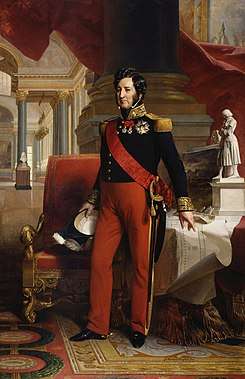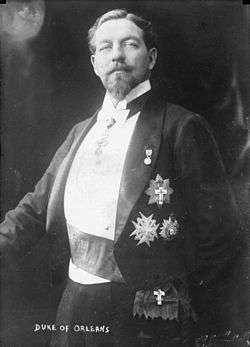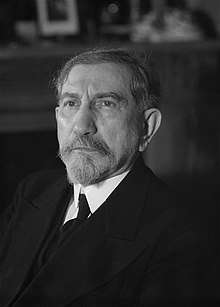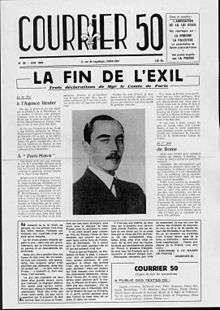Orléanist
Orléanist (French: Orléaniste) was a 19th-century French political label originally used by those who supported a constitutional monarchy, expressed by the House of Orléans.[1] Due to the radical political changes that occurred during that century in France, three different phases of Orléanism can be identified:
- The "pure" Orléanism: constituted by those who supported the constitutional reign of Louis Philippe I (1830–1848), and showed liberal and moderate ideas.[2]
- The "fusionist" Orléanism: the movement formed by pure Orléanists and Legitimists (nicknamed "Whites from Eu") who after the death of Henri, Count of Chambord in 1883, endorsed Philippe, Count of Paris, grandson of Louis Philippe, as his successor.[3] After the fusion, the movement was driven to more conservative stances.[4]
- The "progressive" Orléanism: the majority of "fusionists" who, after the decline of monarchist sentiment in the 1890s, joined into moderate republicans, who showed progressive and secular-minded goals,[5] or into Catholic rally, like the Liberal Action.[6]
| French royal family Orléanist |
|---|
.svg.png) |
|
|
Extended royal family |
It was opposed by the two other monarchist trends: the Bonapartism, that supported Napoleon’s legacy and heirs, and the Legitimism, that was loyal to the traditional monarchy of the House of Bourbon after 1830.
Under the July Monarchy

On 26 July 1830, the revolution of the so-called Three Glorious Days (or July Revolution) erupted due to the authoritarian and anti-Gallican tendencies showed by Charles X and his Prime Minister Jules de Polignac, expressed by the recently approved Saint-Cloud Ordinances.[7][8] Despite the abdication of Charles X and the Dauphin Louis in favor to Charles X's grandson Henri, Duke of Bordeaux, on 2 August 1830, only seven days later Louis Philippe I, still Duke of Orléans, was elected by the Chamber of Deputies as new "King of the French".[9] The enthronement of Louis Philippe was strongly wanted by Doctrinaires, the liberal opposition to Charles X's ministries, under the concept "nationalize the monarchy and royalize France".[10] On 14 August 1830, the Chamber approved a new Constitution, who became the de facto political manifesto for the Orléanists, containing the basis for a constitutional monarchy with a central Parliament. The Orléanism, became the dominant tendency within political life, easily divided inside the Chamber of Deputies between the centre-left of Adolphe Thiers[11] and the centre-right of François Guizot.[12] Louis Philippe showed himself more aligned with Guizot, entrusted to the higher offices of government, and rapidly became associated with the rising "new men" of the banks, industries and finance,[13] gaining the epithet of "Roi bourgeois".[14] In the early 1840s, Louis Philippe's popularity decreased, due to his strong connection to upper classes and repression against workers' strikes, and showed few concerns for his weakened position, leading the writer Victor Hugo to describe him as "a men with many little qualities".[15] The Orléanist regime finally fell in 1848, when a revolution erupted and on 24 February Louis Philippe abdicated in favor to his grandson Philippe, Count of Paris, under regency of his mother Helene, Duchess of Orléans, who was quickly ousted out from the Chamber of Deputies during the regency's formalization, who was interrupted by republican deputies who instead proclaimed the Second Republic.[16]
After 18 years of reign, Louis Philippe left the Orléanist base well-defined inside the magistrature, the press, universities and academies, especially the Académie française.[6] However, also some great aristocratic families joined the court, like the Dukes of Broglie,[17] as well former Bonapartist officers like the Marshal Soult and Édouard Mortier. This establishment constituted the majority of the Party of Order, led by Thiers, who represented the conservatives and monarchists under the Second Republic.[18]
Under the Third Republic
Fusion and restoration project
| Electoral results | |||||
|---|---|---|---|---|---|
| Year | No. of overall votes |
% of overall vote |
No. of overall seats won | ||
| National Assembly | |||||
| 1871 | Unknown (1st) | 33.5% | 214 / 638 | ||
| Chamber of Deputies | |||||
| 1876 | 554,117 (6th) | 7.5% | 40 / 533 | ||
| 1877 | 169,834 (5th) | 2.1% | 11 / 521 | ||
| 1881 | 552,971 (5th) | 7.7% | 42 / 545 | ||
| 1885 | 991,188 (4th) | 12.2% | 73 / 584 | ||
| 1889 | 994,173 (4th) | 12.5% | 72 / 576 | ||
| 1893 | 816,789 (3th) | 10.5% | 63 / 574 | ||
| 1898 | 607,960 (5th) | 7.5% | 44 / 585 | ||

The Orléanism revived after the French defeat in the Franco-Prussian War of 1870, that caused the fall of the Second Empire, succeeded to the Second Republic by Napoleon III, former President of France enthroned after the coup d'état of 1851.[6] The Second Empire was succeeded itself officially in 1871 by the Third Republic. A National Assembly, composed by 638 on 778 seats, was formed and new elections were called for the 8 February of the same year, which resulted in a victory for the monarchist rights: 396 seats won, divided to 214 Orléanists and 182 Legitimists, nicknamed "cavalrymen".[20] Initially divided about the dynastic issue, the Orléanists found a compromise with the Legitimists, supporting the rights of Henri, Count of Chambord (former Duke of Bordeaux, currently childless) in return of the recognition of the Count of Paris as his heir, echoing an 1862 statement of Chambord.[21] Although Chambord never mentioned the Count of Paris as his heir, probably fearing the defection of his ultraconservative supporters,[22] the informal agreement sanctioned the "fusion" of Legitimists and Orléanists, who quite easily formed a conservative coalition. The monarchist majority, led by the Duke of Aumale (son of Louis Philippe), and the centre-left endorsed the centre-right candidate Thiers as President of the Republic, but due to the continue arguments between Legitimists and Orléanists and the memory about the dynastic divisions of the past 40 years, Thiers moved to support a "conservative republic" instead a divided monarchy.[23]
Due to Chambord's dislike toward Aumale,[24] the "fusionists" rapidly passed under the leadership of the Duke of Broglie, who in 1873 successfully managed the election of President Patrice de MacMahon, former general and national hero who showed Legitimist sympathies, considering him as a kind of "lieutenant-general of the kingdom" before the fully restoration of Chambord on the throne.[25] Broglie was shortly after awarded with the premiership by Mac Mahon, supported by monarchists and the centre-right. Restoration appeared imminent when a parliamentary commission was established in October 1873 to adopt a monarchist constitution. But in the same month the majority was weakened by the refusal of Chambord to accept the French Tricolour, used since 1830, preferring instead the return of the royal white flag, symbol of the Ancien Régime.[24] The question was apparently resolved with a compromise between Broglie and Chambord: the last will accept the tricolour flag while a future agreement about a new flag will be considered. In October the majority was shocked when the centre-right representative Charles Savary rashly misinformed the press of Chambord's full acceptance of the tricolour flag,[24]. The pretender had to harshly clarify his position, causing the left of the centre-right, Orléanists disappointment and the dissolution of the "restoration" commission on 31 October 1873. A last attempt by Chambord was made on 12 November, when he asked President MacMahon via the Duke of Blacas to join with him into the National Assembly and spoke toward the representatives, hoping to convince them to restore the monarchy, but MacMahon refused due to his institutional position, toward he was formally even if not ideologically attached, causing the project's failure.[26] Due to the impossibility to restore the monarchy in a short time, the Orléanists waited the death of the sickly Chambord, occurred in 1883, but by that time, enthusiasm for a monarchy had faded, and as a result the Count of Paris was never offered the French throne.[27]
The monarchists, however, still controlled the National Assembly, and under MacMahon's partisan presidency they launched the so-called "moral order government", in reference to the bloody suppression of the Paris Commune, whose political and social innovations were viewed as morally degenerate by large conservative segments of the French population.[28] In February 1875, a series of parliamentary acts established the constitutional laws of the new republic. At its head was a President of the Republic. A two-chamber parliament consisting of a directly-elected Chamber of Deputies and an indirectly-elected Senate was created, along with a ministry under the President of the Council (prime minister), who was nominally answerable to both the President of the Republic and the legislature. Throughout the 1870s, the issue of whether a monarchy should replace the republic dominated public debate. On 16 May 1877, with public opinion swinging heavily in favour of a republic after the election of March, President MacMahon made one last desperate attempt to salvage the monarchical cause by dismissing the "conservative republican" prime minister Jules Simon and appointing the Duke of Broglie to office. He then dissolved parliament and called a general election for the following October. If his hope had been to halt the move towards republicanism, it backfired spectacularly, with the president being accused of having staged a constitutional coup d'état known as "16 May Crisis" after the date on which it happened. Republicans returned triumphantly after the October elections for the Chamber of Deputies. The crisis ultimately sealed the defeat of the royalist movement, and was instrumental in creating the conditions of the longevity of the Third Republic:[29] in January 1879 the Republicans gained control of the Senate, formerly monopolized by monarchists. MacMahon himself resigned on 30 January 1879, leaving a seriously weakened presidency in the hands of Jules Grévy, leader of the Republican Left.[30][31]
The end of the presidency Mac Mahon and the Senate's loss caused the end of the monarchist bloc. Although there were Orléanist deputies in the Chamber for all the 19th century, they were only a minority. At the end, many monarchists accepted the republic, moving toward the centre. Some Orléanists, especially from their bourgeoise core base, accepted the republic even since the 1870s, like Thiers and press baron Émile de Girardin. In 1892, after Pope Leo XIII's approval to the Third Republic, breaking the historical alliance between Church and Crown,[32] some monarchists led by Orléanist Jacques Piou and Legitimist Albert de Mun formed the group of the "ralliés" ("supporters"), that in 1901 constituted the base of the first Christian Democratic party in France, the Liberal Action,[33] while many other royalists were still attached to the Crown.
Association with the far-right

The elections of 1898 confirmed the exclusion of the monarchists from any possible government. However, 4 years earlier, the Dreyfus affair shook public opinion, dividing the republican camp: socialists, radicals and liberals defended the innocence of Dreyfus,[34] while other republicans joined the nationalists and monarchists against Dreyfus.[35] The election also introduced 10 overtly anti-Semitic representatives, led by Édouard Drumont.[36] The following year, on 20 June 1899, the academic Henri Vaugeois and journalist Maurice Pujo founded the nationalist association Action française, initially absent of any specific ideology.[6] However, the Action was joined by many Catholics and monarchists who were anti-Dreyfus, contributing to the move of the association toward the right. Particularly, the adhesion of Charles Maurras, considered a "pragmatic" anti-Dreyfusard rather than a true anti-Semite,[37] contributed to the creation of the ideology of the Action, which rapidly became the main monarchist group. Maurras, despite becoming the movement's ideologist, supported not a classical monarchy on religious term (divine right) but a positivist one, stating that a monarchy would grant more order and stability than a parliamentary republic.[6] The largest group of French monarchists, after the death of Chambord in 1883, endorsed the Count of Paris until his death in 1894, recognizing the claim of his son Philippe, Duke of Orléans, who was also supported by the Action.[6] However, monarchism inside the Action was always integrated secondary to its semi-official ideology of "integral nationalism" theorized by Maurras,[38] and many Action activists were still republicans, like the founder Vaugeois.[6] The movement grew to be one of the largest organizations in France, but in 1926 a condemnation from Pope Pius XI against the Action caused the defection of many Catholic sympathizers. The Pope judged that it was folly for the French Church to continue to tie its fortunes to the unlikely dream of a monarchist restoration, and distrusted the movement's tendency to defend the Catholic religion in merely utilitarian and nationalistic terms,[39] and the Action Française never recovered from the condemnation.[40]
By 1934, the Action was still a considerable force, with over 60,000 members across France.[41] In that year, they joined other far-right leagues on 6 February demonstrations against political corruption and the Parliament, causing the resignation of Prime Minister Édouard Daladier the day after and provoking fear of a nationalist coup d'état.[42] The papal condemnation, the aggressive tactics, and Maurras's disrespectful attitude toward constitutional monarchists finally ended the organization as a major power. The Orléanist pretender Jean, Duke of Guise, who in 1937 broken ties with the Action, also lost many supporters. From this moment, Orléanism ceased to be associated with the Action or the far-right.[16] Instead, the Duke of Guise's son and heir Henri, Count of Paris, launched his own magazine Courier Royale and secretly dealt with anti-fascist conservative General La Rocque, leader of the French Social Party, about the possibility of a restoration.[43]
Hope during the Fourth Republic

In 1946, the Count of Paris (who succeeded his father in 1940) moved to Portugal due to the ban against former royals still present in France. Due to the unstable situation of the Fourth Republic, characterized like its predecessor by short governments and a high presence of parties, the Count of Paris made a serious attempt to restore the monarchy. He endorsed the Christian Democratic Popular Republican Movement (MPR), and formed a kind of political committee composed by academics Bertrand de Jouvenel, Gustave Thibon and Michel de Saint Pierre,[44] publishing on 5 February 1948 the manifesto Esquisse d'une constitution monarchique et démocratique, promoting the idea of a constitutional monarchy.[44] Thanks to the MPR deputy Paul Hutin-Desgrées (co-founder of Ouest-France), the exile law was abrogated on 24 June 1950, permitting the return of the Count of Paris to the capital, meeting also President Vincent Auriol.[44] The Count and his family took their home in the Parisian suburbs of Louveciennes, gaining quick fastly the media's attention. Orléans took frequently parties and meetings, attended by prominent politicians of the Fourth Republic, such as Antoine Pinay, Jacques Soustelle, Pierre Mendès France and Maurice Schumann.[44] Through his newsletter Courier 50, the Count of Paris expressed supports for the policies of Mendès France, like the peace in Indochina, the refusal of a US-controlled European Defence Community (EDC) and decolonization of French Africa.[44]
Orléans relationship with Charles de Gaulle was also promising, like the general and the pretender had similar political views and were both devout Catholics.[44] When De Gaulle became Prime Minister in 1958, it was expected by the Count of Paris to restore the monarchy, but instead De Gaulle preferred strengthen the republican institutions, eventually driving to the establishment of the present-day Fifth Republic. De Gaulle was elected President in 1959, and seem to have been promised to the Count of Paris that he wouldn't run again for the election of 1965, instead supporting the candidacy of the pretender that would promote a reform for change the republic to a constitutional monarchy.[45] However, in 1963 De Gaulle confided to his minister Alain Peyrefitte that, despite his respect and esteem for the Count of Paris, he never considered him as his successor to the presidency, stating that the idea of a monarchy was out of time.[46] Disappointed by the false hopes and promises, the Count of Paris retired from political life in 1967, ending also the publications of his newsletter.
Legacy
The Orléanist party, despite the different regimes, maintained his bourgeois platform, constituted by those academics, journalists and financiers who backed Louis Philippe during his reign, and was intended as the liberal centre of politics, far from reactionary Legitimists and revolutionary republicans.[47][48] However, for all the span of Louis Philippe's reign, the Orléanists weren't a homogeneous party, but simply the majority who supported the constitutional system. Only after the establishment of the Second French Republic in 1848 and the division inside right-wing factions about the monarchy type that the Orléanist party found unity, supporting a parliamentary system instead of an executive one.
On early 20th century, the majority of Orléanists accepted the republican institutions, approving the parliamentary system and pro-business policy realized by republican majority, who reflected the historical Orléanist purposes.[6] French historian René Rémond included the presidency of Valéry Giscard d'Estaing as part of the Orléanist tradition, due to his liberal issues and equidistance from the nationalist right (heiress of the Bonapartism) and conservative one (heiress of the Legitimism).[49] The term "Orléanist parlamentarism" was also used by jurist and sociologist Maurice Duverger to define the form of government of the Fifth Republic, which present a parliamentary system with a powerful head of state.[50]
In 1974, before the incumbent presidential election, the New Royal Action (NAR), born by a moderate faction spilled from the Action française, endorsed Bertrand Renouvin for the presidency, with the purpose to restore a constitutional monarchy led by Orléans, followed by centrist and liberal positions on other issues. The results presented only 43,722 votes (0.17 per cent).
Bibliography

- Aston, Nigel (1988). Orleanism, 1780–1830. History Today. 38.
- Broglie, Gabriel de (1981). Perrin (ed.). L'Orléanisme: La ressource libérale de la France (in French).
- Broglie, Gabriel de (2011). Fayard (ed.). La Monarchie de Juillet (in French).
- Robert, Hervé (1992). PUF (ed.). L'orléanisme (in French).
- Beik, Paul (1965). Van Nostrand Reinhold (ed.). Louis Philippe and the July Monarchy.
- Collingham, H. A. C. (1988). Longman (ed.). The July Monarchy: A Political History of France, 1830–1848.
- Howarth, T. E. B. (1962). Citizen-King: The Life of Louis Philippe, King of the French.
- Poisson, Georges (1999). Perrin (ed.). Les Orléans, Une famille en quête d'un trône (in French).
- Newman, Edgar; Simpson, Robert (1987). Greenwood Press (ed.). Historical Dictionary of France from the 1815 Restoration to the Second Empire.
- Rémond, René (1966). University of Pennsylvania Press (ed.). The Right Wing in France: From 1815 to de Gaulle.
- Passmore, Kevin (2013). The Right in France from the Third Republic to Vichy. Oxford University Press. pp. 25–26.
- Montplaisir, Daniel de (2008). Perrin (ed.). Le Comte de Chambord, dernier roi de France (in French).
- Montplaisir, Daniel de (2011). Jacob-Duvernet (ed.). Louis XX, petit-fils du roi Soleil (in French).
References
- "Le dictionnaire de l'Histoire - Légitimiste, orléaniste". Herodote.net (in French).
- Broglie 2011, p. 464.
- Poisson, Georges (2009). Pygmalion (ed.). Le comte de Chambord: Henri V (in French). p. 316.
- Robert 1992, pp. 39–40.
- Rémond 1966, pp. 163–169.
- Rémond (1966).
- Brown, Bradford C. (2009), "France, 1830 Revolution", The International Encyclopedia of Revolution and Protest, American Cancer Society, pp. 1–8, doi:10.1002/9781405198073.wbierp0573, ISBN 9781405198073
- Europe 1789 to 1914 : encyclopedia of the age of industry and empire. Merriman, John M., Winter, J. M. Detroit, Mich.: Charles Scribner's Sons. 2006. ISBN 978-0684314969. OCLC 76769541.CS1 maint: others (link)
- "Louis-Philippe Biography". The Biography.com Website. Retrieved 13 May 2014.
-

- Agulhon, Maurice (1983). The Republican Experiment, 1848–1852. Cambridge University Press. p. 135.
- Passmore 2013, pp. 25–26.
- Demeester, Emma (2016). "François Guizot, du libéralisme au conservatisme". La Nouvelle Revue d'histoire, n.89 (in French). pp. 32–34.
- Bienfait, Bérangère (October 30, 2018). "Louis-Philippe, un roi bourgeois, bâtisseur et entrepreneur". Point de Vue (in French).
- Hugo, Victor (1972). Gallimard (ed.). Choses vues 1847–1848 (in French). p. 248.
- Poisson (1999).
- Lancien, Didier (2007). Maison des Sciences de l'Homme (ed.). Anciennes et nouvelles aristocraties: De 1880 à nos jours (in French). pp. 100–101.
- "Parti de l'Ordre". Larousse.
- Pinoteau, Hervé (1983). Nouvelles Editions Latines (ed.). Etat de l'Ordre du Saint-Esprit en 1830 ; et, La survivance des ordres du roi (in French).
- Lejeune, Dominique (1994). Armand Colin (ed.). La France des débuts de la IIIe République, 1870–1896 (in French). p. 10.
- La Besge, Émile de (1971). Perrin (ed.). Souvenir et récits de chasse (in French).
- Dreux-Brézé, Henri de (1899). Perrin (ed.). Notes et Souvenirs pour servir à l'histoire du parti royaliste (in French). pp. 227–234.
- Mayeur, Jean-Marie (1984). Seuil (ed.). La Vie politique sous la IIIe République. p. 44.
- Montplaisir (2008).
- Broglie, Albert de (1929). La Revue des Deux Mondes (ed.). Mémoires, IIIe partie, l'avènement de la République (II) (in French). LIV. p. 594.
- Broglie, Gabriel (2000). Perrin (ed.). Mac Mahon (in French). pp. 247–251.
- Dale, Steven D. (1988). The Monarchy According to the King: The Ideological Content of the 'Drapeau Blanc,' 1871–1873. French History. II. pp. 399–426.
- Brogan, D.W. Brogan (1940). Greenwood Press (ed.). France Under the Republic: The Development of Modern France (1870–1939). pp. 106–13.
- Brogan (1940) pp. 127–43.
- "François Paul Jules Grévy is Born". Masonry Today. 2017.
- "Jules Grevy". World presidents DB. 2017.
- Pope Leo XIII (February 16, 1892). Inter Sollicitudines.
- Piou, Jacques (1914). Hachette (ed.). Le comte Albert de Mun (in French). p. 206.
- Jaurès, Jean (1933). Rieder (ed.). Études socialistes II, 1897–1901 (in French). pp. 189–218.
- Bredin, Jean-Denis (1983). France Loisirs (ed.). L'Affaire (in French). p. 475.
- Levy, Richard S. (2005). ABC-CLIO (ed.). Antisemitism: A historical encyclopedia of prejudice and persecution. p. 191.
- Giocanti, Stéphane (2006). Flammarion (ed.). Charles Maurras: le chaos et l'ordre (in French). p. 167.
- Rouvillois, Frédéric (2005). Flammarion (ed.). Droit constitutionnel: Fondements et pratiques (in French). p. 191.
- Latourette, Kenneth (1969). Zondervan (ed.). Christianity in a Revolutionary Age. pp. 37–38.
- Weber, Weber (1962). Action Française: Royalism and Reaction in Twentieth-Century France. Stanford U.P. p. 249. ISBN 9780804701341. Archived from the original on 5 May 2016.
- Schor, Ralph (2005). Complexe (ed.). L'antisémitisme en France dans l'entre-deux-guerres: prélude à Vichy (in French). p. 29.
- Colton, Joel (1969). Warner (ed.). From the Ancien Regime to the Popular Front. p. 183.
- J. F. (October 22, 1938). "Comment j'ai été "kidnappé" par le comte de Paris". Le Populaire (in French).
- Montplaisir (2011).
- Natal, Frederic (October 1, 2016). La couronne (ed.). "Le général Charles de Gaulle a-t-il voulu restaurer la monarchie?" (in French).
- Peyrefitte, Alain (1997). Fayard (ed.). C'était de Gaulle. II. pp. 531–533.
- Craiutu, Aurelian (2003). Liberalism under Siege: The Political Thought of the French Doctrinaires. Lexington Books. p. 9.
- Takeda, Chinatsu (2018). Mme de Staël and Political Liberalism in France. Springer. pp. 226–227.
- Slama, Alain-Gérard Slama (2006). Vous avez dit bonapartiste?. L'Histoire n. 313. pp. 60–63.
- Duverger, Maurice (1959). "Les institutions de la Ve République". Revue française de science politique, n. 1.
See also
- Line of succession to the French throne (Orléanist)
- Succession to the French throne
- French dynastic disputes
- Alliance Royale
- New Royalist Action
- French Action